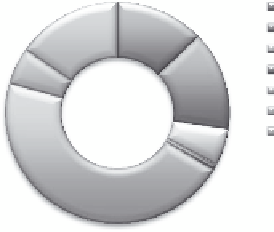Information Technology Reference
In-Depth Information
The analysis of data quality (see Figure 1.3) shows that OGD is available free
of charge in all cases. The data accuracy requirement, that is, that the data content
matches the information described in the catalogue, is also met in all the portals
analyzed. As for the timeliness of the data, that is, the requirement that the data
provided in OGD portals be up to date and not merely historical, this question is
measured by the number of days the least up-to-date information has remained on
the portal; in this respect, the results show that Germany is the country with the
most up-to-date OGD. However, it should be clarified that we were not able to
measure this parameter in all cases (see Figure 1.3).
Only Italy, Portugal, and Slovakia provide a glossary of relevant terms in their
OGD portals, and only six portals enable external users to add new data. Therefore,
it seems that these OGD portals fail to make best use of the possibilities offered by
the platform as a tool for public participation and communication.
The fourth analytic approach concerns the content of the OGD portals. With
regard to the categories into which the catalogues are grouped (see Figure 1.4), most
catalogues contain information of a social nature; this is true of 46.4% of the OGD
portals, whereas meteorological content is the least commonly found, in only 0.8%
(see Figure 1.13). However, the number of catalogues provided in an OGD portal
is not necessarily conclusive because an OGD that has a catalogue for each category
(provided that each catalogue contains an adequate quantity of information) can be
considered more complete than one with many catalogues in all possible categories
but which provides little significant information in each catalogue.
The total volume of data was the dimension that presented the greatest disper-
sion. In this respect, the UK and France were at the forefront, with 17,849 and
12,896 data files, respectively, whereas Sweden had only 42, and in another four
portals, it was impossible to determine the total number of files available (see Figure
1.4). As for the number of agencies providing the data, this information could not
be determined in six cases. France was outstanding in this respect, deriving its
OGD from 265 agencies (see Figure 1.4).
Finally, we analyzed the types of filters that can be applied in performing a data
search. The most commonly found were those enabling the user to browse by category
Business data
Geographic data
Legal data
Meteorological data
Social data
Transport data
Other
13%
16%
5%
15%
5%
1%
46%
Figure 1.13
Categories.

Search WWH ::

Custom Search